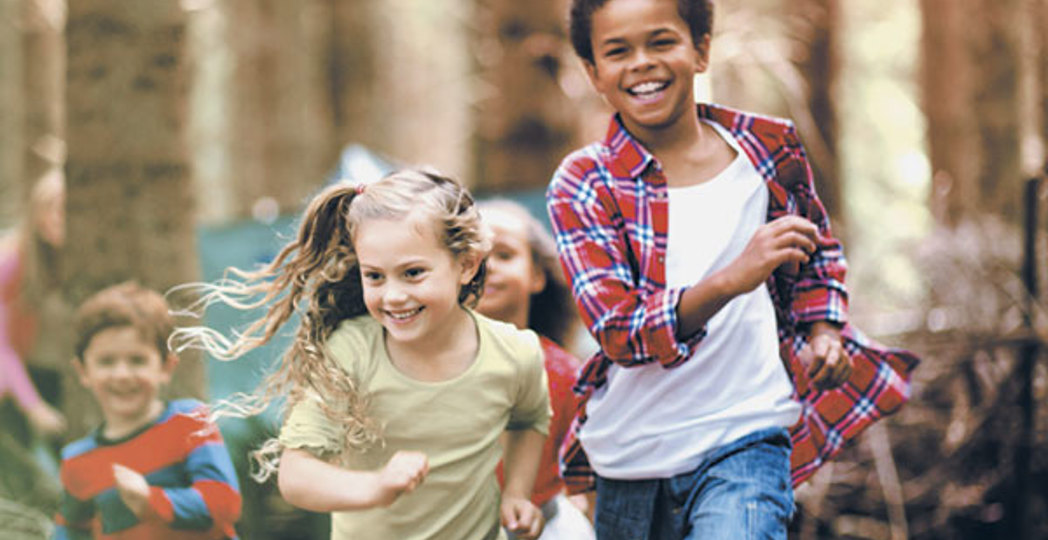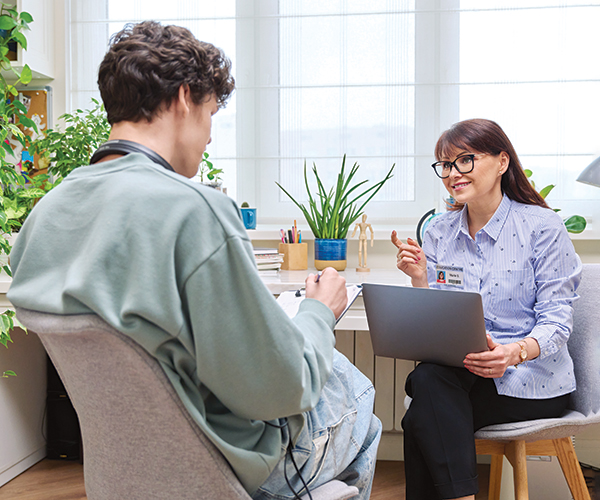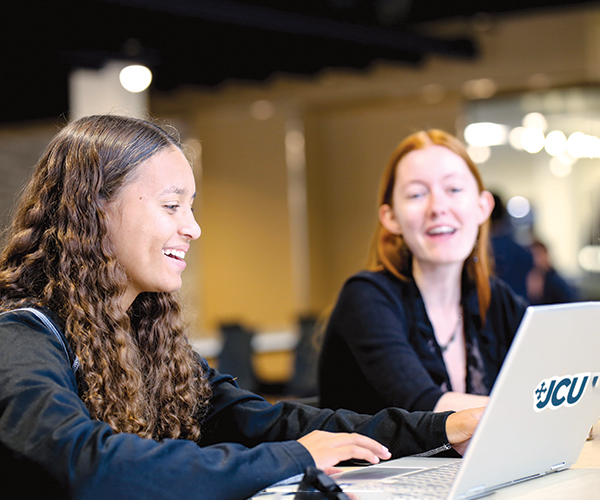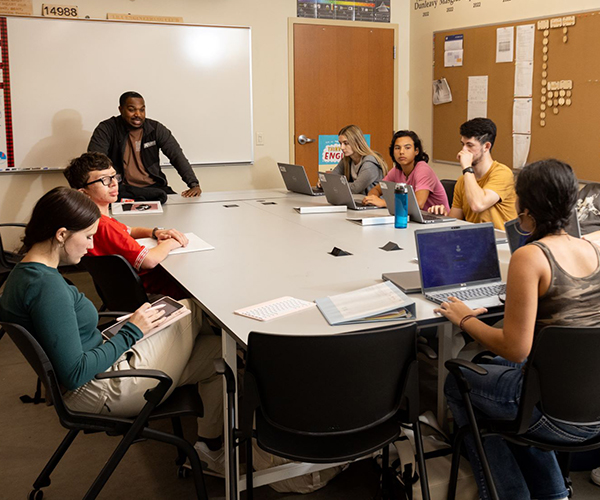Play Your Way Back to School
by Kristen Hampshire | Aug. 8, 2016 | 6:00 PM

August is summer-activity crunch time — you got to squeeze in every ounce of sprinkler-running, popsicle-licking fun before school starts. If you’re stuck on how to make the most of these last few weeks, we’ve got a dozen (plus one) super fun ideas designed to prepare the kiddos for school days. (They won’t even realize your plan to plug them back into learning mode.)
The best part: You can easily implement these playful, purposeful ideas with minimal time, resources and energy. Because let’s face it, we’re low on all of these things come summer’s end.
Jump into Learning
Summer is built for barefoot chasing, baseball throwing and creek crossing. The Great Lakes Science Center’s Sports Arena exhibit means you won’t have to slow down the fun to build some momentum for September. With 14 activity stations, Sports Arena teaches kids what it takes for the body to master basic moves (walking) and elite feats such as a 10-meter race against Olympian Jackie Joyner-Kersee. “The exhibit shows the science behind what makes our bodies perform the way they do and best practice to help your body achieve better results,” says Karyn Saunders, school programs manager at the Great Lakes Science Center.
Try it: Make like a gymnast by jumping from a 2-foot platform and attempting to land soft like a cat on a pad that measures the impact. “This shows the force of your body and how you absorb impact,” Saunders says, adding that a bones exhibit illustrates how your skeleton deals with such a landing. You’ll marvel at the body’s resilience. “It’s unusual for a science exhibit to be so active.”
Stretch it: Watch the Summer Olympics Aug. 5-21 and discuss the science behind the athletes’ feats, based on what your kids experienced at the exhibit. They’ll gain insight into the mechanics behind winning that gold, Saunders says.
Level Up to Reading
If your child reaches for electronics rather than books, you’re not alone. Maria Trivisonno, public services librarian in the children’s department at Cuyahoga County Library’s Warrensville Heights branch, suggests drawing on those outside interests to power up their desire to read.
Consider the Minecraft novel series for avid gamers, nonfiction sports books for young athletes or the paperback version of a favorite movie.
“There are always ways we can break into a child’s interests if you are willing to ask a librarian for suggestions,” Trivisonno says.
Try it: “Let the child read what they want,” Trivisonno says. “Do not be afraid if they reach for the graphic novels — let them.”
Stretch it: To find an appropriate reading level, Trivisonno suggests using the “five-finger rule.” Open a book to any page and ask your child to read aloud. A child should not stumble over more than five words.
’SUP Kids’ Eco-Awareness
Amber Kramer loves the open blue of Lake Erie. For the Rocky River mother of two girls, it’s a place to press the mental reset button and focus on mind, body and the surroundings. Hooked on stand-up paddleboarding for four years, Kramer began introducing her 8-year-old daughter, Ellie, to the sport while she was in kindergarten.
“She’d wear her life jacket and sit on the front of the board, playing with her Barbie mermaids while I’d paddle,” Kramer says.
Kramer rented a board for her 13-year-old, Katie, to try for herself. “You’re balancing, moving a paddle. If you fall off, you get wet,” she says. “No big deal.“
Now, the Kramers take to the water together with two kayaks and two paddleboards. The kids learn water safety and environmental awareness. “We talk about what being a good steward is, and every time we go out we bring a bag so we can pick up trash,” Kramer says. “If we see cigarette butts, we pick them up.”
Try it: Rent a board and get some kids’ lessons at 41 North Coastal Kayak Adventures in the Emerald Necklace Marina.
Stretch it: Kramer recommends replacing zip-close bags with reusable containers for school lunches. “We see the waste out on the water and beaches, and we don’t want to contribute to the problem.”
Build Design Skills
Take your craft game to new levels at Cuyahoga County Public Library’s Innovation Centers, which offer drop-in training and 3-D printing equipment at the Parma-Snow, Garfield Heights and Mayfield branches. Drop-in orientations include a 30- to 60-minute session to learn 3-D printing basics.
With adult supervision, kids can create fun shapes and characters using Tinkercad, a simple computer-aided design software program tailored to teachers, hobbyists and children. Make the design at home, then email it to the library to print (at an associated cost) and bring the idea to 3-D life.
Try it: Tinkercad can be fun on its own. Create an account and walk through some simple lessons on how to scale, copy and paste shapes, letters and designs. You can even make a key ring with your name. (Be careful, it can get addicting.)
Stretch it: Start with a drawing to show how 2-D ideas become 3-D reality. Use modeling clay to play with a form — an exercise in early engineering. The base design can be put into Tinkercad for 3-D printing. The process teaches how to follow through with steps and grows an appreciation for the design process.
Create a Backyard Obstacle Course
Build language and gross motor skills with a backyard obstacle course.
You don’t need fancy equipment. Trees can serve as blockades for preschool- and early elementary-aged children to run around. A couple of lawn chairs and a blanket can form a tent to crawl under.
Instruct your kids to go around, over, under, in, across — which helps build preschoolers’ vocabulary, says Ellen Spear, speech language pathologist and co-owner of Lakeshore Speech Therapy in Westlake. These directional words can get confusing for young ones, she notes.
Kids will also learn to complete a task, practice balance, improve gross motor skills and motor planning. This can impact a child’s performance in school skills such as handwriting and maintaining energy.
Try it: Start small with a few steps, such as obstacles for over, under and around. Use outdoor toys or items you already have in the backyard. Rings positioned in a pattern make stepping “stones” kids jump in and across.
Stretch it: Older children can advance from ground-level skills to greater challenges, says Emily Fein, program director, Girl Scouts of North East Ohio. The organization operates Camp Timberlane in Wakeman, which offers a 6-acre lake, boating, challenge course and observatory. “These authentic challenges allow kids to gain confidence,” Fein says.
Stage a Treasure Hunt
Build reasoning, problem-solving and critical thinking skills with an old-fashioned backyard treasure hunt with clues tailored to your child’s age. Speech language pathologist Ellen Spear suggests a letter hunt. For example, find something in the backyard that starts with the letter T.
Creating structured play in the summer helps build listening skills and emphasizes follow-through. “It can be small increments,” Spear says. “Because the goal is also to complete a task.”
Try it: Come up with five to 10 items to hunt for in your surroundings. Give children clues using descriptive language such as: “Find something shaped like a rectangle and starts with the letter B. (That could be a brick in your patio.)
Stretch it: Take your treasure hunt on the road to the grocery store, museum or park. A car trip can serve as a time to engage young passengers in their surroundings with this visual game, Spear says.
Map a Trail
No matter where you live in Northeast Ohio, you’re within 15 minutes of a park with a trail system. “Get kids engaged in the activity of solving mysteries,” says Wendy Weirich, Cleveland Metroparks director of outdoor experiences. “In nature, as you’re walking around, you don’t know what’s around the next corner — a deer, mink, turkey. It’s unpredictable and exciting.”
Jenny Maloney, a former Parma middle school science teacher with three sons ages 6, 4 1/2 and 2, encourages her kids to hunt for clues such as animal tracks along the trail. “The outdoors calms the kids like nothing else,” Maloney says. “We are always having conversations about what we see and what we are looking for.”
Try it: Download the Cleveland Metroparks app, complete with maps. “Many people say they don’t want to go into the woods because they’re afraid they’ll get lost, so here is your tool,” says Weirich.
Stretch it: Keep a travel journal of what you find. Ignite curiosity on the trail by encouraging children to take pictures. Then visit one of the Metroparks’ five nature centers and ask a naturalist, “What’s that?” Weirich suggests.
Pick Your Own
Teach children that produce doesn’t grow at the store by taking them to a farmers market or a pick-your-own farm. At the market, make a list of fruits and veggies to buy and put your little one in charge of finding the goods. This sharpens awareness, and a list creates structure and hones organizational skills.
“There is math with buying items and learning about nutrition,” says Carolyn Ievers-Landis, a developmental, behavioral and pediatrics psychologist at University Hospitals Rainbow Babies & Children’s Hospital. “These experiences can be so rich — and they’re simple things.”
Try it: Set on 70 acres overlooking the Cuyahoga Valley, Rosby Berry Farm in Brooklyn Heights is a great place to collect red raspberries in early August.
Stretch it: Talk about what you can make with your bounty, then go home and cook together. Cooking hones skills such as reading, following directions, measuring and patience. Also, children are more likely to try new foods that they help prepare. “The key is to be thoughtful and realize that downtime and casual activities do have very positive learning opportunities,” Ievers-Landis says.
Clean Out
Simple household tasks can teach children important skills. With the start of school approaching, clear out closets to make room for cool-weather clothing or put away toys that never got played with. Kids can learn sorting, organizing and decision-making.
“Trying to make judgment calls as to what to keep and what to give away is important,” Ievers-Landis says. Plus, donating unused goods to charity offers its own rewards.
Try it: Delegate a clean-out task to your children to give them responsibility for a small project. For example, suggest they tackle one dresser drawer or one shelf of toys or books.
Stretch it: Take children to a place such as a church or charity that collects used goods. Teach them how clothing that no longer fits, and toys that were sitting on the shelf, are welcome gifts to those in need.
Experiment with Science
Former middle school teacher Jenny Maloney stages weekly science experiments with her sons. “The boys look on Pinterest and find experiments they want to do,” she says. By inviting school friends or neighbors to participate, you gain a twofold benefit of building curiosity and social skills.
Try it: Start simple with experiments that have just a few steps. Maloney set up an experiment to teach some basic engineering by building with gumdrops, marshmallows and toothpicks. Ask your children to help you gather supplies. Including them in the preparation, experiment and cleanup teaches follow-through. Ask questions during the experiment: “What do you think will happen next?”
Stretch it: Maloney keeps a journal of all the science experiments her family has tried over the years. “We either record the results or draw a picture and write words to describe it,” she says. This adds a creative element to the process, and a period to reflect on what the kids saw.
Color an Interest
Combine color recognition and outdoor discovery by creating a simple “color hike” that can happen in a nearby park or in your own yard. Emily Fein, Girl Scouts of North East Ohio program director, picks up paint chips at home improvement stores and saves them for these occasions.
“We look for different colors outside in nature and talk about which colors are easy to find and which ones are more difficult to find,” Fein says.
Try it: Cut out pieces from magazine pictures as color strips. This sharpens children’s fine motor and cutting skills, which are important for pre-kindergartners and beyond.
Stretch it: Add a magnifying glass to explore the details of colors your children find. Notice the veins on leaves; see the tiny ants marching across a mossy rock. “This engages a child’s sense of discovery and causes them to focus a bit more on the world,” Fein says.
Geocache On the Fly
Next time you’re at the park, on a walk in your neighborhood or exploring a new city on vacation, check if there is a nearby geocache full of surprises. Geocaching uses GPS coordinates to find little hidden treasures, which can range from simple-and-small containers with logs to sign to more elaborate caches containing little trinkets: marbles, quarters, toy figures. All you need is a smartphone and the Geocaching app to get started.
Emily Gunn, mother of four, started geocaching with her children a few years ago. Her kids, ages 9, 7, 3 and 1, call it “treasuring hunting,” and they have found caches of goody bag-type surprises at their local parks, rec center and along trails.
“We walk to places where we wouldn’t normal go, and there is a purpose,” Gunn says. “There’s something out there to find.”
Try it: The next time you’re out and about, launch a sporadic treasure hunt using the Geocaching app. It sparks curiosity and teaches math skills. You can use the app alone or use a compass and follow the coordinates orienteering-style.
Stretch it: Geocaching is also a lesson in give-and-take. You take a treasure, then leave one behind for others to find. Talk to your children about what items you can gather to leave for others. “You want someone else to find the cache and have that joy,” Gunn relates.
Sample the Arts
August is not too late to take in summer art classes at Lakewood’s Beck Center for the Arts. Kids can get a taste of different forms of creative expression with the Arts Sampler Camp (Aug. 15-19, ages 7 to 12) and Ballet Contemporary Sampler Camp (Aug. 15-18, ages 12 to 18).
“It’s a chance to branch out into different art forms and test them with hands-on activities,” says Ed Gallagher, director of education for Beck Center.
Try it: Drop in for the Red Stage Summer Music Series, a free outdoor concert with local musicians at the Beck Center. “It’s a great way to learn about and hear different styles of music,” Gallagher says. Red Stage performances are Aug. 10 (Uno Lady and Mike Uva) and Aug. 24 (Boy = Girl).
Stretch it: Super Saturdays @ Beck Center are quarterly creative hooplas that target ages 7 and younger with a 30-minute concert, singalong, hands-on music and art making. Admission is free (but reserve tickets online) for the Aug. 20 event.
Trending
-
1
-
2
-
3
-
4
-
5










